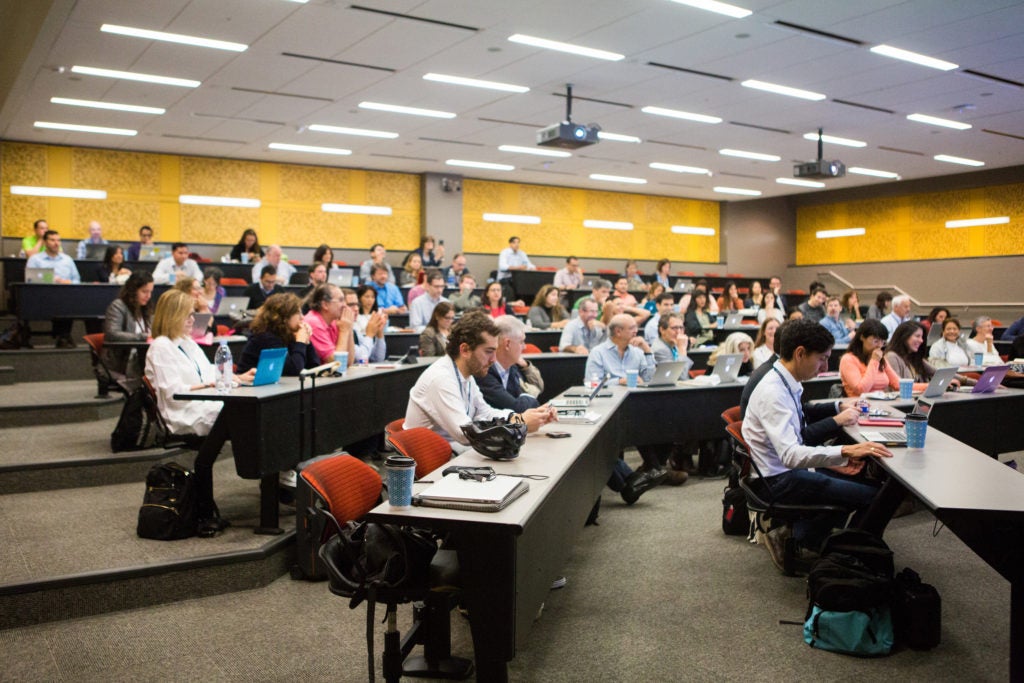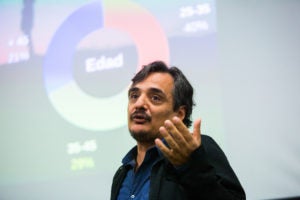April 28, 2017 | Coloquio
Journalists from Ibero-America share innovation projects at the Knight Center’s Colloquium on Digital Journalism
(*)For other coverage of the 10th Ibero American Colloquium for Digital Journalism, please see below.
Innovation is opening up more and more paths in traditional and digital media in the Spanish-speaking world thanks to interesting journalistic projects in Latin America and Spain, which have gradually found ways to tackle technological and funding challenges.

This was according to the journalists who participated in the 10th Ibero-American Colloquium on Digital Journalism, celebrated on April 23 with support from Google Latin America, at the conclusion of the 18th International Online Journalism Symposium (ISOJ) at the University of Texas in Austin.
More than 20 representatives of digital native and traditional sites that have transitioned to the internet presented the innovative initiatives they have put in place. Some of them focused their presentations on the results they have obtained in recent months and others in the ways in which they have financed their projects.
Cross-platform research takes up a lot of space in the list of projects developed last year in Spanish-speaking territory. An example is “Vacaciones en Aguas de Nadie” (“Vacations in No Man’s Sea”), a project presented by Nathalie Alvaray, editorial director of Univision Noticias Digital.
This is an investigation designed for mobile devices about the reality behind the cruise industry in the United States. The project, which includes long-form reports, animated graphics, videos and infographics, generated 180 thousand visits and won the Ortega y Gasset Award for Best Multimedia Coverage.
“This is not a success of traffic, it is a success of innovation, of space for experimentation and teamwork,” Alvaray said. “Many of the processes we set up to do this work are used today in the newsroom.”
Another successful case of a multiplatform project is “Geografía del Dolor” (“Geography of Pain”), presented by the Mexican journalist Mónica González, of Red de Periodistas de a Pie. The work shows a mapping of stories of violence collected during a tour of areas of Mexico struck by crime.

“The goal was to gather testimonies of what was not being said and to go directly to those places to ask people what was happening to them at their core,” González said. “The issue is what matters, the medium or the messenger can be any of the tools to reach the largest audience.”
“Geography of Pain” also includes documentary videos and photo galleries. An exhibition and a book also resulted from the project.
Data journalism was also a recurring theme during the Colloquium presentations, such as that of Sandra Barrón, a 2017 Knight Visiting Nieman Fellow from Mexico, who developed a Data Standard for Missing Persons.
The project consists of an information platform on missing individuals, regardless of the cause of their disappearance. The platform aims to be useful for civil organizations seeking people in a country where disappearance is a social phenomenon surrounded by opacity and disinformation.
Barrón said that the methodology of her project, which matches criteria such as identity, biography, genetics and immigration status of the disappeared, can be applied in other countries with similar cases.
Projects such as that of Barrón are proof that social conflicts are hotbeds for innovative journalistic projects with potential social impact. Such is the case of Venezuela’s Efecto Cocuyo, which, because of the political situation in that country, has seen the need to look for innovative options for coverage and financing.
Laura Weffer, co-founder and editorial director of the site, shared how Efecto Cocuyo found in Periscope an innovative and powerful way to cover the multiple marches that have taken place in the South American country in recent months.

“The protests in Venezuela have unleashed the creativity of the people, which is why Efecto Cocuyo has had to be creative and innovate,” Weffer said. “Periscope has worked for us to overcome censorship, and we interact with people in real time. That provides us with a plus when it comes to coverage. ”
That kind of involvement of the audience in social networks is something that all media in Latin America are looking for. Colombian journalist Juanita León, director of the investigative journalism site La Silla Vacía, stressed that one of the formulas that her media has applied to achieve this can be seen in the “Cadenas Chequeadas” project, which verifies the authenticity of news circulated in WhatsApp channels.
“It’s amazing how many lies circulate [by WhatsApp],” León said. “’Cadenas Chequeadas’ (Checked Channels) is a way to get to where conversations are actually taking place and interact with information that people actually interact with.”
León shared that the site has managed to renew sponsorships with the brands that finance its “La Silla Llena” section, in which they develop networks of thematic investigations, even though the cost of those sponsorships increased 30 percent.
Agustín D’Empaire, manager of digital platforms for Canal ElTrece in Argentina, spoke about the social media strategy implemented by his media outlet, which has resulted in an audience of 70 million monthly views alone on Facebook.

ElTrece’s strategy to create a community includes the production of an exclusive content grid for social networks. D’Empaire said that in order to decide on that content, they should identify the issues that are trending at that time.
“We work on a course of action that is to detect relevant conversation topics in networks. We use tools like Webtrends,” he said. “We produce pieces for the networks that have their own narrative.”
ElTrece, which belongs to Grupo Clarín’s Artear, is backed by a media company that has the necessary infrastructure to carry out its projects. By contrast, independent digital media are constantly looking for creative and innovative financing modes.
One case presented at the Colloquium was that of porCausa, a non-profit organization that seeks to promote investigative journalism and support those who produce stories about social issues such as poverty, inequality and migration.
Lula Rodríguez-Alarcón, director of the foundation, said it is funded through crowdfunding and donations from partners who are interested in promoting the issues they address.
“We created this foundation as a reaction to the impoverishment of journalism that was being done in Spain on social issues. We seek to be a support for anyone who wants to work on social issues and we have designed a whole system to help journalists,” said Rodríguez-Alarcón, who added that this support ranges from help in editing to orientation on topics.
In order to develop its projects, porCausa works in collaboration with universities in Spain and with important media in the country like El País and eldiario.es.
Collaborations between media and of media with institutions is also a growing issue in Latin America. Digital media such as Convoca from Peru, are a good example of this. The director of the site, Milagros Salazar, said that her bet is to make alliances in investigative journalism projects on subjects in which they can generate changes.
The journalist pointed out that in the past few months, they have had successful collaborations on issues of political corruption such as the LavaJato corruption network and the Panama Papers. In addition, the site recently launched podcasts and a production workshop on that platform.
“While we measure the audience of the products we develop, we also measure the impact from the changes we can contribute to,” Salazar said. “Our bet is to duplicate the good and learn from what does not work. We develop collaborative work because that allows us to be sustainable, not only in financial terms, but also at a human level. ”
In Latin America, collaboration not only occurs between the media. Faced with the reduction of newsrooms and economic crises in the media, freelance journalists are increasingly given opportunities to participate in relevant projects, according to Juan Pablo Meneses, a Chilean journalist and Knight Fellow at Stanford University.

Meneses presented results from the Census of Freelance Journalists Working in Spanish, which aims to create a database with information on the identity, age, income and work that journalists working independently have done. The census counts information of 1,200 Spanish-speaking journalists from Latin America and the United States.
“It is clear that there is more and more freelance journalism in Spanish. Big corporations are increasingly working with freelance, but we do not know who these journalists are, what they are doing, how they have changed,” said Meneses, who found that there is a trend among freelance journalists to want to remain independent without seeking to join a media organization.
Among the journalists who came to the Ibero-American Colloquium on Digital Journalism for the first time was Silvia Ulloa, director of Costa Rican digital newspaper CRhoy.com.
The journalist shared that the news site, which has a staff of 10 multifunctional journalists, has managed to consolidate itself as a media outlet of reference with its own coverage in its country, thanks to investigations that have impacted society or led to the overthrow of politicians.
An example of this is the work in which they unveiled the fiscal defraudation of the two most important media in Costa Rica.
“For CRhoy.com it was important to generate a critical mass to follow us, and it was important to position ourselves in the market,” Ulloa said. “We have triumphed over 70 years of traditional media, their experience, their brand and their power.”
(*) More coverage of the 10th Ibero American Colloquium for Digital Journalism:
- Latin American and Spanish news sites experiment to reach audience and finance quality journalism
- SembraMedia reveals digital media growth in Latin America, but says organizations still face challenges
- Google News Lab launches operations in Latin America to help journalists with tools and training

